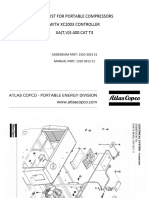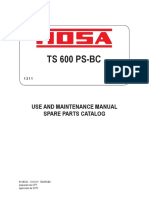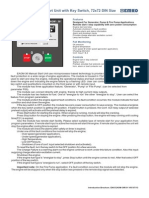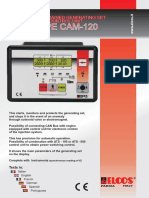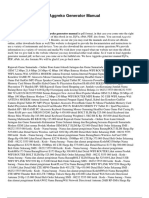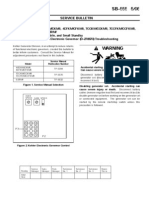100%(1)100% found this document useful (1 vote)
543 viewsKde12sta3 en
Kde12sta3 en
Uploaded by
Carlos GonzaloThis document provides instructions for operating a generator. It outlines several pre-start check items including engine oil, coolant, fuel, and electrical components. It then details 12 sections covering technical specifications, preparatory steps, safety procedures, start-up, operation, stopping, controls, troubleshooting, and electrical diagrams. The preparatory steps section emphasizes checking fluid levels and components before starting and warns of hot and moving parts during operation.
Copyright:
© All Rights Reserved
Available Formats
Download as PDF, TXT or read online from Scribd
Kde12sta3 en
Kde12sta3 en
Uploaded by
Carlos Gonzalo100%(1)100% found this document useful (1 vote)
543 views4 pagesThis document provides instructions for operating a generator. It outlines several pre-start check items including engine oil, coolant, fuel, and electrical components. It then details 12 sections covering technical specifications, preparatory steps, safety procedures, start-up, operation, stopping, controls, troubleshooting, and electrical diagrams. The preparatory steps section emphasizes checking fluid levels and components before starting and warns of hot and moving parts during operation.
Original Title
Kde12sta3 En
Copyright
© © All Rights Reserved
Available Formats
PDF, TXT or read online from Scribd
Share this document
Did you find this document useful?
Is this content inappropriate?
This document provides instructions for operating a generator. It outlines several pre-start check items including engine oil, coolant, fuel, and electrical components. It then details 12 sections covering technical specifications, preparatory steps, safety procedures, start-up, operation, stopping, controls, troubleshooting, and electrical diagrams. The preparatory steps section emphasizes checking fluid levels and components before starting and warns of hot and moving parts during operation.
Copyright:
© All Rights Reserved
Available Formats
Download as PDF, TXT or read online from Scribd
Download as pdf or txt
100%(1)100% found this document useful (1 vote)
543 views4 pagesKde12sta3 en
Kde12sta3 en
Uploaded by
Carlos GonzaloThis document provides instructions for operating a generator. It outlines several pre-start check items including engine oil, coolant, fuel, and electrical components. It then details 12 sections covering technical specifications, preparatory steps, safety procedures, start-up, operation, stopping, controls, troubleshooting, and electrical diagrams. The preparatory steps section emphasizes checking fluid levels and components before starting and warns of hot and moving parts during operation.
Copyright:
© All Rights Reserved
Available Formats
Download as PDF, TXT or read online from Scribd
Download as pdf or txt
You are on page 1of 4
2-3 Check the following items for the initial start:
(1) Check the engine oil
(2) Check the cooling water in radiator.
(3) Check the fuel.
(4) Check the fuel pipe.
(5) Check the battery electrolyte.
(6) Check the grounding protection.
(7) Check the water leakage and oil leakage.
(8) Check the looseness of the parts.
1. Main Technical Specifications and Data
2. Preparatory Steps for Operation
3. Safety procedure for Servicing
4. Warm-up Procedure
5. Starting-up Procedure and running
6. Stop Procedure
7. The Functions of the Digital Panel
8. Electrical appliance
9. Simplified Troubleshooting Guide
10. Malfunction and Countermeasures
11. Electrical Wiring Diagram
4
6
13
14
15
16
17
19
20
26
28
1. Main Technical Specifications and Data
- - - - - - - -
- - - - - - - -
2. PREPARATORY STEPS FOR OPERATION
NOTE: Screw down
GENERATOR OPERATION MANUAL
KIPOR POWER CO., LTD.
PREFACE
Congratulation and thank you for your purchase of KIPOR unit. Our aim
is to provide a high-quality generator set to achieve customer
satisfaction, and we are confident that your choice will be justified.
This manual dealing with the generator side of the unit, gives all basic
information to ensure satisfactory and reliable operation of KIPOR unit.
Please use this manual as a companion to the other manual covering
the engine side.
CAUTION
1. Use SAE 10W-30 lubrication oil. After the first oil change at 10
hours operation.
2. Do not connect the generator output to commercial AC outlets.
3. For information about the engine operation and maintenance,
please see KIPOR engine's manual.
CONTENTS
1. Environmental Requirements
1-1 Outdoors use
1) Install Generator in a dry and dustless place
2) Avoid the direct sunshine, place Generator in shade
3)Keep Generator on a lever ground so that the unit will not move by
itself. For safely, fix the unit on the ground by pegging.
1-2 Indoor use
1) Use in well-ventilated areas, or vent exhaust outside and away from
any building air intakes. A large volume of air is required for the
operation.
2) Keep the air inlet/outlet and the exhaust gas outlet 1.5m away from
any obstacle.
3) Use under 40 degrees temperature.
4) Install Generator on a lever surface.
2. Preparation for the engine
2-1 Initial start check
Check the each part of the generator before starting.
Making sure that anybody near the generator is warned, before starting
the generator.
Be care of these parts in the generator, such as rotary parts, hot parts,
high-voltage parts. Start the engine after closing the door to avoid noise
hurt and any unexpected accident
Stop the engine at once and check for the fault,
if the warning lamps light.
Check the unit for oil leakage, water leakage,
air leakage and abnormal sound.
2-2 Initial start check
The rotary parts are dangerous!
The high-speed rotating parts are very dangerous when the generator is
running.
Close the side doors when running the unit.
Service the unit after its engine stops completely.
CAUTION
CAUTION
DANGER
60
9.5
10.5
240/120
39.6/79.2
3600
50
9.5
10.5
400/230
13.7
3000
60
10.5
11.5
416/240
14.6
3600
MODEL
ITEM
G
e
n
e
r
a
t
o
r
Fuel Consumption (g/kw.h)
Overall Dimension (L x Wx H) (mm)
Rated Rotation Speed (r/min)
1.0 0.8 (lag)
12 hours continuous running
E Open -frame type; T: silent type
Rotation Shaft Steel Connection
E: 155 T: 250
E: 1000x600x650 T:1100X615X810
340
Transistorized self-excitation and constant voltage(AVR)
Model Specifications:
E: open-frame type T: silent type ST: Super silence
A: digital panel 3: three-phase
MODEL
ITEM
E
n
g
i
n
e
Mode
Type
Discharge capacity (ml)
Combustion Oil
Decompression
Standard Power (KVA)
Tank Volume (L)
Cylinder diameter x Stroke (mm)
Combustion Oil Tank Volume (L)
Starting Mode /Battery Volume
KM2V80
794
80 X 79
0 ~ 35 Diesel
2.27
23
12 14.5 12 14.5
12V Electric Starter /36AH or 50AH
26
Two-cylinder, V-twins, Air-cooled, 4-stroke, Bow-wave type
Rated Frequency(Hz)
Rated Power (KVA)
Max Power (KVA)
Rated Voltage (V)
Rated Current (A)
Phase
Power Factor (cos )
Excitation Mode
Working Mode
Structure Mode
Connecting Mode
Dry Weight (kg)
50
8.5
9.5
230
37.0
3000
Single-phase Three-phase
KDE12E KDE12T
KDE12EA KDE12TA
KDE12STA KDE12ST
KDE12E3 KDE12T3
KDE12EA3 KDE12TA3
KDE12ST3 KDESTA3
KDE12E KDE12T
KDE12EA KDE12TA
KDE12STA KDE12ST
KDE12E3 KDE12T3
KDE12EA3 KDE12TA3
KDE12ST3 KDESTA3
- - - - - - - -
- - - - - - - -
3. SAFETY PRECATIONS FOR SERVICING 4. WARM-UP PROCEDURE 5. STARTING-UP&RUNNING PROCEDURE
(9) Clean the dirty and dusty in the unit.
1) Check the engine oil
a) Check the engine oil level with oil dipstick. And the oil level should be
between the H (high) and L (low) positions.
b) If the oil level is lower than L position, add the engine oil.
c) Check if the engine is clean or not.
The engine oil decreases slowly when unit is
running continuously. In order to avoid lacking
of engine oil to cause fault , inspect the oil
level and add engine oil if necessary.
2) Check the cooling water in radiator.
( please refer to the other manual)
Radiator
Be careful of the hot radiator. It's very dangerous to open the radiator
cover when the cooling water is very hot. The vapor and splashed water
may scald you seriously.
Don't open the radiator cover when the engine is running or after the
engine is stopped just for a while. Because the cooling water
temperature is very high in this time.
CAUTION
CAUTION
Check the cooling water after the engine stops.
Open the radiator cover when check it, check the radiator if full of the
cooling water or not.
Tighten the radiator cover by turn it in right
after checking. Otherwise, the cooling water
may be vaporized, causing a fatal fault.
3) Check the fan belt
Check the tension and the extend length of the belt. Check the belt if
good or not. Replace it if necessary. Refer to its engine manual for the
regulation or replacement of the belt.
4) Check the fuel
Check the fuel level if normal before running the generator. Often open
the drain plug in the fuel tank to drain the sediment and impurity.
5) Check the battery electrolyte
The usage of the battery
The battery electrolyte contains sulfur acid. It may cause fire hazard if
handle it by mistaken.
CAUTION
CAUTION
As a most serious result, it may cause blindness. Take off the cover of
the battery, check the electrolyte level if up to the specified level. If not,
add the distilled water.
6) Check the grounding protection
The generator frame and load generator frame must be installed
grounding protection, and make sure the grounding protection is ok.
7) Check the water leakage and oil leakage.
Inspect the wholly unit and open the door to check if there is water
leakage and oil leakage. If there is, please contact with your dealer for
service.
8) Check the looseness of the parts
Check the nuts and screws if loosened. If loosened, tighten them.
Specially inspect the air cleaner, muffler, and charging alternator.
Pay attention to the broken cables and loosened terminals.
9) Clean the dirty and dusty in the unit.
Check the unit inner for dusty and dirty and clean it.
Check the muffler and the places near the engine for trash or flammable
materials and clean them.
Check the intake and exhaust port if clogged by the dirty. Clean it, if
necessary.
(10) Electrical connection with load
Make sure that load does not exceed the power capacity of your
KIPOR unit . Connect electrical connections properly.
Connect the welding cable according to the prescribed cable size.
1. Only qualified persons should test, maintain, and repair this unit.
2. Always wear a face shield, rubber gloves and protective clothing
when working on the unit.
3. Do not touch the generator unit or any part of load with your bare
hands or wet hands.
4. Keep hands, hair, loose clothing, and tools away from moving parts,
such as fans, belts and rotors.
5. Do not breathe exhaust gas.
6. Stop engine and let it cool off before checking or adding fuel.
7. Do not add fuel while smoking or unit is near any sparks or open
flames.
8. Observe correct polarity (+& -) on batteries.
9. Do not tip battery.
10. Use equipment of adequate capacity to lift and support unit and
components.
1. Check the fuel oil every day.
2. Check if the engine oil reaches the scale of stipulating.
3. Check the water lever, and fill the cooled-water full.
4. Check the fan strap's degree of tightness
5. Turn the fuel cock to ON position.
6. Set the main switch to OFF.
7. Turn the engine start key to START position.
8. Warm-up time is about 3-5 minutes.
NOTE: Speed controller has adjusted well before transporting. So don't
adjust it at random, or it will cause the engine rotation speed too high or
too low.
1. According to the step of 1-9, finish the starting-up procedure.
2. Ensure voltmeter indicates normal, (single phase: 230V, three phase:
400V)
3. Set the main switch to ON.
4. Observe the voltage is in the normal loaded range.
5. Preheat generator three minute without load after the set starting,
then running with load
6. The new generator set have a running-in period, the period is the
initial 20 hours, only with 50% load during the running-in period, or it will
shorten the set life.
7. Checks during the running
1) Whether there is abnormal sound or vibration;
2) Whether the engine misfires or runs rough;
3) Check the color of the exhaust. (Is it black or too white?)
If you notice any of the above-mentioned phenomenon happened, stop
the engine and find out the fault cause or contact with our agents.
Upper limit
Lower limit
If the engine has been running, the muffler will be very hot.
Be careful not to touch the muffler.
Never refill the fuel tank while the engine is running.
CAUTION
Do not start 2 or more machines simultaneously. Start them one by
one.
Do not use floodlight together with other machines.
CAUTION
8. Load
9. AC application
1) Be sure to run the generating set at rated speed, otherwise AVR
(Automatic Voltage Regulator) will produce the forced excitation. If the
running is for a long time under such condition, AVR will be burned out.
2) After switching on the air switch, observe the voltmeter on the panel
of the control cabinet, the voltmeter should point to 230V 5% (50Hz)
for single-phase generating set; 400V 5%(50Hz)for three-phase
generating set, then the loading can be carried out.
3) When the double voltage generating set changes over the voltage,
the air switch should be set at OFF position. Otherwise the generating
set and electric devices will be burned out and damaged.
4) Connect the equipment to the generating set in order. For the matter
of the motor load, firstly the heave-duty motor should be connected, and
then the light-duty motors. If the operation is false, the generating set
will lag or stop suddenly. It is necessary to unload the generating set
immediately and turn off the main switch and do checks.
- - - - - - - -
- - - - - - - -
8. ELECTRIC APPLIANCE
Electric appliance particularly motor-driven equipment will produce very
high current while starting, the below table provides the reference for
connecting these apparatus to the generator set.
5) Three-phase generating set
Balance three phases during the operation. Stop the engine for check
if the tolerances exceed 20%. Be sure to keep the tolerance among
three phases less than 20%.
The load for each phase must below the rated load as well as the
current must less than rated current.
A, B, C, D (or U, V, W, N) phase arrangement should be from left to right,
or clockwise.
Concerning starting the three phases asynchronous motors, first start
the heavy-duty motors, and then start the light-duty motors.
If overloading of the circuit trips the AC circuit protector, reduce the
electrical load on the circuit, and wait a few minutes before resuming
operation.
CAUTION
6. STOP PROCEDURE
1. Set the main switch to OFF.
2. Turn the engine start key to STOP position.
3. Close the fuel cock.
Knob function:
ITEM: switch the content of display, the content include: battery voltage,
running time, output frequency, output current, generator voltage
CLEAR: stop alarm and go out kinds of fault indicator.
START: start the generator
STOP: stop the generato
r
Indicator function:
BATTERY VOLTAGE: indicate battery voltage
RUNNING TIME: indicate generator-running time
OUTPUT FREQUENCY: indicate generatorfrequency.
7. THE FUNCTIONS OF THE DIGITAL PANEL
RUNNING
OVERLOAD
LOWER OIL PRESSURE
START FAULT BATTERY VOLTAGE OUTPUT CURRENT
PROTECTION RUNNING TIME VOLTAGE
EMERGENCY STOP OUT FREQUENCY LONG-RANGE CONTROL
DISPLAY
ITEM
CLEAR
START
STOP
OUTPUT CURRENT: indicate generator current
VOLTAGE: indicate generator voltage
LONG-RANGE CONTROL: indicate long-range control using if or not
RUNNING: indicate electric power exist if or not
OVERLOAD: indicate overload, the generator will self-braking
LOWER OIL PRESSURE: indicate lower oil pressure, the generator will
self-braking
START FAULT: indicate failure start
PROTECTION: indicate voltage & frequency higher (lower), the
generator will self-braking
EMERGENCY STOP: indicate stop generator according to emergency
Measure
1. Maintenance Schedule
Check and clean replace
1000 50 250 500
First
First
Check fuel, drain out sediment and impurity
Check & service item
Check engine oil
Check the cooling water
Check fan belt
Check battery electrolyte
Check for water or oil leakage
Check the loosen assembly
Check the exhaust color
Check meters and warming light
Replace engine oil
Replace oil filter element
Clean air cleaner element
Check battery electrolyte density
Clean the radiator
Replace seal ring of fuel filter element
Daily check
E
n
g
in
e
This guide is intended to give brief information for troubleshooting with
no testing or measuring instruments to check the unit.
However, testing and measuring instruments are required to diagnose
parts and components in many trouble cases.
If you cannot determine the cause by visual inspection, you should
consult your dealer whom you purchased this unit from.
9. SIMPLIFIED TROUBLESHOOTING GUIDE
2. Troubleshooting
Rotating part
It's very dangerous to touch the rotating parts in the generator.
Stop the engine to service and maintain the inner parts of the unit.
Don't service the electric fan until it stops entirely.
Electric shock
Don't touch the inner parts with high voltage during the running.
Stop the engine to service and maintain the inner structure.
Hot part
Let the engine cool before storing the generator indoors.
To prevent scalding, pay attention to the warning marks attached to
the generator.
Close and lock the door, when running the super quiet generator. And
don't put hand and head into the engine to avoid scalding.
The usage of the battery
It will explode to cause a severe accident if the battery used in a
wrong way.
Remove the negative terminal when servicing the generator.
DANGER
DANGER
CAUTION
CAUTION
: Consult with KIPOR dealers.
: It is the time for the first check. From then on, check the items
according to the normal period.
The check time is different form its engine type. Please read the
operation manual carefully.
Check circuit terminal and connection
1000
Clean the inner of the fuel tank.
Replace the air cleaner element
Check valve clearance.
Adjust fuel nozzle.
Check fuel injection time.
Check damper rubber.
Check if the relay can work
Measure insulated resistance
50 250 500
First
Check protection for electrical leakage
Check the nylon tube & rubber tube
Check & service item Daily check
E
n
g
in
e
G
e
n
e
r
a
to
r
10. MALFUNCTION AND COUNTERMEASURES
TYPE
WATTAGE
STARTING RATED
TYPICAL
APPLIANCE
EXAMPLE
APPLIANCE
Fluoresc-
ent
lamp
Incande-
scent
lamp
Heating
appliance
Motor-
driven
equip-
ment
X1
X2
X3~5
X1
X1.5
X2
Incandescent
lamp
Fluorescent
lamp
Refrigerator
Refrigerator
150W
100VA
(W)
80VA
(W)
450-750VA
(W)
40W
100W TV
100VA
(W)
60VA
(W)
300VA
Electric
fan
Projection
lamp
Sodium
lamp
Halide
lamp
Switch
power
Eliminator
Power
X2 X2
X2 X2
400W
1kVA
800VA
(W)
800VA
(W)
2kVA
(kW)
2kVA
(kW)
STARTING RATED
Incandescent
lamp
Fluorescent
lamp
Rectifier
cabinet
Converter
cabinet
Halide lamp
Projection lamp
- - - - - - - -
- -
11. ELECTRICAL WIRING DIAGRAM
Reason
Bad voltmeter
Bad AVR
Loading short circuit
Generator rotate speed is too low
Rotor circuitry break
Engine circuitry is burnt.
Bad voltmeter
Bad AVR
Loading is over
Generator rotate speed is too low
Generator cable is burnt.
Rotation speed is too low.
Bad voltmeter
Bad AVR
AVR connection is loose
Bad AVR
Main winding is burnt.
Load is not equal.
Welding current is abnormal
IGBT is burned
Rotation speed is too low
Wiring is too long between
generator and overload.
Solution
Replace voltmeter
Consult with KIPOR dealer
Eliminate it
Adjust the speed
Replace
Replace
Consult with KIPOR dealer
Reduce the overload
Adjust the speed
Maintain
Increase the speed
Replace
Consult with KIPOR dealer
Reinstalled the receptacle
Change motor
Make them equal.
Change motor
Change IGBT
Increase rotation speed
Fault
T
h
e
v
o
lta
g
e
v
a
lu
e
is
n
o
t r
ig
h
t o
r
th
e
r
e
is
n
o
v
o
lta
g
e
.
T
h
e
g
e
n
e
r
a
to
r
c
a
n
't r
e
a
c
h
r
a
te
d
v
o
lta
g
e
Adjust the distance and widen
the wiring.
Over voltage
V
o
lta
g
e
d
e
c
r
e
a
s
e
s
to
o
m
u
c
h
w
h
e
n
c
o
n
n
e
c
te
d
w
ith
lo
a
d
Welding current is too small
Welding current
is abnormal
1. KDE12E
3. Judge and elimininate troubles
S
ta
r
t m
o
to
r
r
u
n
b
u
t d
o
e
s
n
't s
ta
r
t
S
ta
r
t m
o
to
r
d
o
e
s
n
't r
u
n
o
r
it's
s
p
e
e
d
is
s
o
s
lo
w
A
m
b
ie
n
t te
m
p
e
r
a
tu
r
e
is
v
e
r
y
lo
w
Battery leakage
Battery unclamped or rut
The earth terminal is imperfect
Start switch badness
Starter badness
The wire breaks
No fuel oil
Fuel oil cleaner walled up
Air in the oil pipe
Liquid measure
Install after cleaning
Repair
Replace
Replace
Repair
Fill oil
Clean , and replace fuel oil cleaner
Empty air
S
to
p
a
u
to
m
a
tic
,
ro
ta
te
s
p
e
e
d
d
o
e
s
n
't ris
e
Some water accumulated in
the fuel system is frozen.
Fuel is frozen
Fuel winding does not work
Empty air
Mend the engine
Replace air cleaner element
Use winter oil, or choose the applicable
viscosity oil according to the freeze area
Check the fuse, if disconnection, replace
it ,check and replace winding if necessary
Heat, empty fuel oil tank ,fuel oil cleaner
and water in oil pipe
Replace fuel oil cleaner element, clean or replace filter
Bad Air around pipe
Fuel oil cleaner walled up
Badness water of pipe oil
Air cleaner is clogged.
E
n
g
in
e
d
o
e
s
n
't
r
u
n
Reason
engine oil is not enough.
Badness oil switch
Engine air cleaner wall up
Badness regulator
Air in the oil pipe
Regulator position is wrong
Air in the oil pipe
Not fix tightly
Abnormal voice
Bad axletree
fasten bolt loose
Abnormal voice
Check around
If lack cooling-water
Fan strap loose
Vibration is too big
Fault
Engine stops
because of low oil
pressure.
Engine can't
reach the highest
speed
Idle speed is too high
Slow no load speed
A
b
n
o
r
m
a
l n
o
is
e
Engine shell
Engine
Generator
Overheat
Regulator lever regulator position is wrong
Solution
Fill engine oil
Replace switch
Replace filter
Adjust to short
Eliminate air
Adjust regulator lever
Adjust regulator lever
Eliminate air
Fix tightly
Mend
Replace
Tight
Mend
Move thing from
Check if lack cooling water
Maintain fan strap loose
Clean radiator cooled part Radiator cooling orifice wall up
E
x
c
ita
tio
n
W
irin
g
A
V
R
Sample Wiring
Yellow Green RV6.0
Main Wiring
Current Mutual
Lnductor Red RV6.0
Circuit Breaker
Output End
Yellow Green RV0.5
V
ic
e
W
irin
g
Black RV6.0
N
E
L
Black RV0.5
Grey RV0.5
Red RV0.5
Red RV0.5
Voltage Sample
Output
AVR
Protect K1
T
h
ro
ttle
E
le
c
trm
a
g
n
e
t
Blue RV1.0
Power Supply
Switch
Grey RV1.0
E
m
e
e
rg
e
n
cy
K
n
o
b
Green RV1.0
Red BVR6.0 Red RV1.0
FU3(5A)
FU4(20A)
Brown
RV1.0
Red RV1.5
GreenRV0.5 Preheat
+12V
+12V
ON
Overload
Signal
Output
D
ig
ita
l P
a
n
e
l D
is
p
la
y
Red RV2.5
Yellow
RV0.5
Start
Signal
White
RV0.5
Water-
temperature
Brown
RV0.5
Low oil
pressure
K3
K3
White
RV2.5
M
S
ta
rt M
o
to
r
W
a
te
r-te
m
p
e
ra
tu
re
S
w
itc
h
L
o
w
O
il P
re
s
s
u
re
S
w
itc
h
Yellow Green RV0.5
P
re
a
h
e
a
t P
lu
g
Preheat
Relay
FU2(20A)
R
e
d
B
V
R
6
.0
FU1(50A)
K1
W
h
ite
R
V
1
.5
K2
K2
Grey
RV0.5
F
ly
w
h
e
e
l G
e
n
e
ra
te
r
Orange RV0.5 Charge
A
d
ju
s
to
r
B
a
tte
ry
E
x
c
ita
tio
n
W
irin
g
V
ic
e
W
irin
g
Yellow Green RV0.5
A
V
R
Yellow Green RV4.0
Current Mutual
Inductor
Current Mutual
Inductor
Current Mutual
Inductor
Red RV4.0
Green RV4.0
Yellow RV4.0
Black
RV4.0
Red RV0.5
Green RV0.5
Yellow RV0.5
T
h
ro
ttle
E
le
c
trjm
a
g
n
e
t
Green RV0.5
Black RV0.5
Red RV0.5
C
u
rre
n
t S
a
m
p
le
Blue RV11.0
Power Supply Switch
Grey RV1.0
Emergency
Knob
Green
RV1.0
Red RV1.5
Green RV 0.5
Red RV2.5 Yellow RV0.5
Start
Signal
White
RV0.5
White-
temperature
Brown
RV0.5
Low Oil
Pressure
K3
White
RV2.5
S
ta
rt M
o
to
r
M
F
ly
w
h
e
e
l G
e
n
e
ra
to
r
A
d
ju
s
to
r
B
a
tte
ry
Yellow Green RV0.5
W
a
te
r-te
m
p
e
ra
tu
re
S
w
itc
h
L
o
w
O
il P
re
s
s
u
re
S
w
itc
h
Signal
Output
Overload
D
ig
ita
l P
a
n
e
l D
is
p
la
y
D
i
g
i
t
a
l
P
a
n
e
l
C
o
n
t
r
o
l
l
e
r
Orange RV 0.5
ST
Preheat
Relay
Preheat
Plug
R
e
d
B
V
R
6
.0
FU1(50A)
Red BVR6.0 Red RV 1.0
FU3(5A)
FU4(20A)
Brown
RV1.0
Preheat
Charge
+12V
+12V
ON
Voltage Sample
Output
E
m
e
rg
e
n
c
y
S
ig
n
a
lGrey RV0.5
Grey
RV0.5
K1
AVR
Pretect
K2
Sample
Output
Main Wiring Circuit Breaker Output End
U
V
W
N
K1
FU2(20A)
W
h
ite
R
V
1
.5
K3
Receptacle
Yellow RV0.5
K2
1. KDE12E3
R
e
c
e
p
ta
c
le
C
u
rre
n
t S
a
m
p
le
E
m
e
rg
e
n
c
y
S
ig
n
a
l
D
i
g
i
t
a
l
P
a
n
e
l
C
o
n
t
r
o
l
l
e
r
E
- - - - - -
You might also like
- Thinkdiag 2 Automotive Diagnostic Device ManualDocument7 pagesThinkdiag 2 Automotive Diagnostic Device ManualRoberto Hidalgo CalvillaNo ratings yet
- 100 Kva Isb CPG Parts CatlugeDocument62 pages100 Kva Isb CPG Parts CatlugeNikkikumar MaisuriyaNo ratings yet
- An Introduction To Graphene Plasmonics - Gonçalves, NunesDocument457 pagesAn Introduction To Graphene Plasmonics - Gonçalves, NunesLeonardo Marcelino100% (2)
- Briggs & Stratton Service & Troubleshooting Manual Home Generator System - 18Kw and 20KwDocument56 pagesBriggs & Stratton Service & Troubleshooting Manual Home Generator System - 18Kw and 20KwAmeya Janvekar100% (1)
- Page Change LED Display: ATS220 ATS Controller Configuration and Instructions Ver1.0 Panel and DisplayDocument4 pagesPage Change LED Display: ATS220 ATS Controller Configuration and Instructions Ver1.0 Panel and DisplayRafael Castillo100% (1)
- 062 - ARN5A ManualDocument2 pages062 - ARN5A ManualWajahat Aziz MarwatNo ratings yet
- Ts1270610 Noh10nh 24v Rev - DiagramasDocument16 pagesTs1270610 Noh10nh 24v Rev - Diagramascristian faundes100% (1)
- Kohler KK16 - 0519Document5 pagesKohler KK16 - 0519Nguyen Vu Hoang ThachNo ratings yet
- Preventative MaintenanceDocument9 pagesPreventative Maintenancedan100% (1)
- Molecular Dynamics LammpsDocument3 pagesMolecular Dynamics LammpsAndres Felipe SaraviaNo ratings yet
- BCS Mechanical Question 1st PaperDocument6 pagesBCS Mechanical Question 1st Paperpalash_mondal100% (4)
- Data Shhet Volvo Tad733Document2 pagesData Shhet Volvo Tad733cchristtNo ratings yet
- DSE8620 MKII Operator Manual PDFDocument222 pagesDSE8620 MKII Operator Manual PDFKleberson Carlos100% (1)
- SV055IS5Document205 pagesSV055IS5Mario Duran100% (1)
- X0001-0000-65 DCL Exhaust Monitor-Logger Manual September 2018Document30 pagesX0001-0000-65 DCL Exhaust Monitor-Logger Manual September 2018Elias Abou FakhrNo ratings yet
- Fisa 2614Document2 pagesFisa 2614Cristian Barbuceanu100% (1)
- Xas 400 CD t3 Row Xc2003 Supplement 2015Document23 pagesXas 400 CD t3 Row Xc2003 Supplement 2015Luc DumontNo ratings yet
- SB D19 007 GMK Diagnostic ToolsDocument31 pagesSB D19 007 GMK Diagnostic Tools4g liteNo ratings yet
- Kohler GM32335-KP1Document4 pagesKohler GM32335-KP1Amoco NoteNo ratings yet
- TIB 1401 - New Software Version C-Series P4.8Document4 pagesTIB 1401 - New Software Version C-Series P4.8Bart JohnNo ratings yet
- Manual Be23Document24 pagesManual Be23Willy Alexander Ramirez0% (1)
- 25 - Southern Cross - Iso Pump - 100 X 65 - 250 - 1440-2950 RPMDocument1 page25 - Southern Cross - Iso Pump - 100 X 65 - 250 - 1440-2950 RPMFerryNo ratings yet
- Rdso SPN 144Document34 pagesRdso SPN 144aniltejas61100% (1)
- TS 600 PS BC Manual ENGDocument54 pagesTS 600 PS BC Manual ENGMesafint kassieNo ratings yet
- Copex Brochure REFLEX FR-GB 2016Document2 pagesCopex Brochure REFLEX FR-GB 2016Nicolas BourbeyNo ratings yet
- KEYSTART 9700 Series: Manual Start Engine Controller With Automatic Fault Protection ShutdownDocument2 pagesKEYSTART 9700 Series: Manual Start Engine Controller With Automatic Fault Protection ShutdownMohamed R Khamiss100% (1)
- Gottwald ProductsDocument4 pagesGottwald ProductsPedroNo ratings yet
- TYPE ATS-050: Switching Control UnitDocument8 pagesTYPE ATS-050: Switching Control UnitAhmed El-AdawyNo ratings yet
- Eaom-36r Eng v05Document8 pagesEaom-36r Eng v05Khaled KamelNo ratings yet
- b115mp3 P0aea QSG Ww456rtasDocument17 pagesb115mp3 P0aea QSG Ww456rtasRichard Medina100% (1)
- TYPE CAM-120 TYPE CAM-120: Self-Contained Generating Set Control UnitDocument4 pagesTYPE CAM-120 TYPE CAM-120: Self-Contained Generating Set Control UnitFikadu Adimas100% (1)
- Wiring Diagram Dse 7320 Amf PDF FreeDocument1 pageWiring Diagram Dse 7320 Amf PDF FreeSemih GençNo ratings yet
- Parts Catalog: Powertech 8.1 L - 6081 Oem Engine (SN - 199000) (Waterloo)Document1,761 pagesParts Catalog: Powertech 8.1 L - 6081 Oem Engine (SN - 199000) (Waterloo)Richard BurbanoNo ratings yet
- InteliMains 210 DatasheetDocument4 pagesInteliMains 210 DatasheetMaylen Rivas0% (1)
- P550-3 Genset DocsDocument6 pagesP550-3 Genset Docsaung minhtetNo ratings yet
- Instruments: Instrument Panels, PositionDocument45 pagesInstruments: Instrument Panels, Positionssinokrot100% (1)
- Liebherr LHM 250 For Sale - Y.O.M. 1995 - Mobile Harbour CraneDocument13 pagesLiebherr LHM 250 For Sale - Y.O.M. 1995 - Mobile Harbour CraneRUBEN BARTOLOME GARCIANo ratings yet
- Gu 304Document12 pagesGu 304Alejandro CastagnaNo ratings yet
- P500P3/P550E3: Output Ratings Ratings and Performance DataDocument4 pagesP500P3/P550E3: Output Ratings Ratings and Performance DatascribdledeeNo ratings yet
- DS 5110 IDocument2 pagesDS 5110 IOdaliNo ratings yet
- CE6 Accessories - IngDocument24 pagesCE6 Accessories - IngRoberto MerizaldeNo ratings yet
- LXC31X0/LXC39X0 Series Genset ControllerDocument28 pagesLXC31X0/LXC39X0 Series Genset ControllerDaruin Andres Florez CardonaNo ratings yet
- Marelli Gen PDFDocument26 pagesMarelli Gen PDFenkzNo ratings yet
- Cat Electronic Modular Control Panel (EMCP) 4.3 Upgrade KitDocument2 pagesCat Electronic Modular Control Panel (EMCP) 4.3 Upgrade KitKaung KharNo ratings yet
- Ts 25Document90 pagesTs 25ERIK MTZNo ratings yet
- Equipment Brochure AdorDocument84 pagesEquipment Brochure AdorHum Hum0% (1)
- CAT Flash 2016Document327 pagesCAT Flash 2016cells-crosser0xNo ratings yet
- YSGCU:031 - VER 6.02 (GN) : Generator Controller User ManualDocument10 pagesYSGCU:031 - VER 6.02 (GN) : Generator Controller User ManualRajKumar Patel100% (1)
- InteliCharger 65 - 24 AF DatasheetDocument3 pagesInteliCharger 65 - 24 AF Datasheetjean sanchezNo ratings yet
- MT400 Instruction ManualDocument6 pagesMT400 Instruction ManualParesh ChopraNo ratings yet
- Solar Module GSM450-72HCDocument1 pageSolar Module GSM450-72HCTasya SalsabilaNo ratings yet
- Joytick s60 PDFDocument214 pagesJoytick s60 PDFHenry Ponton0% (1)
- Aggreko Generator ManualDocument5 pagesAggreko Generator Manualmuzica cu versuriNo ratings yet
- Battery Charger Operator ManualDocument30 pagesBattery Charger Operator ManualVictor PoquizNo ratings yet
- 5CKMR Service BullitenDocument7 pages5CKMR Service Bullitenchrist6989No ratings yet
- Interactive Schematic: This Document Is Best Viewed at A Screen Resolution of 1024 X 768Document17 pagesInteractive Schematic: This Document Is Best Viewed at A Screen Resolution of 1024 X 768Jose Corcega britoNo ratings yet
- HGM6300D V2.1 enDocument34 pagesHGM6300D V2.1 enSteven BaynesNo ratings yet
- Eavr SeriesDocument10 pagesEavr Serieslethanhtu0105No ratings yet
- Esm-7710 Man Env04Document44 pagesEsm-7710 Man Env04itsirc67No ratings yet
- Instruction For Operation and MaintenanceDocument12 pagesInstruction For Operation and Maintenancesupriyo110No ratings yet
- XP4400/XP4400E Gasoline Powered Generator: Owner's ManualDocument34 pagesXP4400/XP4400E Gasoline Powered Generator: Owner's ManualNicolasNo ratings yet
- Duro Max Generators XP4400-XP4400E ManualDocument32 pagesDuro Max Generators XP4400-XP4400E Manualcmos7No ratings yet
- Installation and Operation Instructions For Custom Mark III CP Series Oil Fired UnitFrom EverandInstallation and Operation Instructions For Custom Mark III CP Series Oil Fired UnitNo ratings yet
- Lecture Slides On Electrostatic ConductorsDocument61 pagesLecture Slides On Electrostatic ConductorsRitick srivastavaNo ratings yet
- PHY-251 Centripetal Force LabDocument7 pagesPHY-251 Centripetal Force LabRenzo Jose Canro CalderonNo ratings yet
- VentSilencerBrochure ImperialDocument9 pagesVentSilencerBrochure ImperialKvvPrasadNo ratings yet
- MLSC2 - WoodwardDocument198 pagesMLSC2 - WoodwardCosme RodolfoNo ratings yet
- Mathematical Methods: Muhammad Usman HamidDocument215 pagesMathematical Methods: Muhammad Usman HamidUsman HamidNo ratings yet
- New Idea For CrushersDesign in Cement FactoriesDocument15 pagesNew Idea For CrushersDesign in Cement FactoriesInternational Journal of Application or Innovation in Engineering & ManagementNo ratings yet
- Nbs Building Science 138Document180 pagesNbs Building Science 138Deviprasad B SNo ratings yet
- Kinetic and Potential Energy Worksheet NameDocument3 pagesKinetic and Potential Energy Worksheet NameNgwee Lambang PacateNo ratings yet
- Solar EnergyDocument11 pagesSolar EnergyShubhaang GuptaNo ratings yet
- Upqc Block DiagramDocument3 pagesUpqc Block DiagramjpsridharNo ratings yet
- (Earth and Space Science (Science Readers) ) Greg Young-Alfred Wegener. Uncovering Plate Tectonics-Shell Education - Teacher Created Materials (2008)Document35 pages(Earth and Space Science (Science Readers) ) Greg Young-Alfred Wegener. Uncovering Plate Tectonics-Shell Education - Teacher Created Materials (2008)Peter GonzálezNo ratings yet
- Gravitation 2Document3 pagesGravitation 2france villNo ratings yet
- Module Sabah Add Math f5Document296 pagesModule Sabah Add Math f5LIM YAN JOE MoeNo ratings yet
- Quinton Restabilirea Terenului BiologicDocument7 pagesQuinton Restabilirea Terenului BiologicAlexandru Cristian StanciuNo ratings yet
- Modelling of Hybrid System (Solar and Wind) For Power Generation SystemDocument4 pagesModelling of Hybrid System (Solar and Wind) For Power Generation SystemInternational Journal of Innovative Science and Research TechnologyNo ratings yet
- MATH PETA 4thDocument56 pagesMATH PETA 4thdurpy minshNo ratings yet
- ISC Class 12 Maths Question Paper Solution 2019Document30 pagesISC Class 12 Maths Question Paper Solution 2019praveenpatidar209No ratings yet
- Classical Mechanics - Model PaperDocument1 pageClassical Mechanics - Model PaperPhysicist ManojNo ratings yet
- High Voltage Direct Current Transmission SyllabusDocument1 pageHigh Voltage Direct Current Transmission Syllabusraju9991No ratings yet
- ACTIVITIESDocument7 pagesACTIVITIESAnonymous irpr3uGyz2100% (2)
- Week 24 Questions (FF)Document4 pagesWeek 24 Questions (FF)Solace HusseinNo ratings yet
- Air CoolerDocument27 pagesAir CoolerEnriqueGDNo ratings yet
- High Compressed Solar Light: (Free, Clean and Infinite Energy)Document1 pageHigh Compressed Solar Light: (Free, Clean and Infinite Energy)Anonymous SV2eVOigNo ratings yet
- Spring Mass Couple PDFDocument52 pagesSpring Mass Couple PDFatiqah umairahNo ratings yet
- Pub644 PDFDocument1 pagePub644 PDFIordan Dan FfnNo ratings yet
- SOWAY Magnetostrictive Position Sensors SDMSS - SDocument3 pagesSOWAY Magnetostrictive Position Sensors SDMSS - SSrinivasNo ratings yet
- CyberhawkDocument91 pagesCyberhawkmohamed al-amirNo ratings yet
















